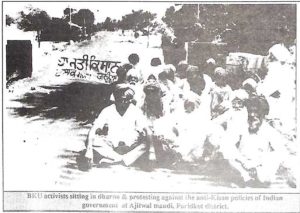Punjab is predominantly an agricultural state with 80% of its population depending upon agriculture. During the last three decades there has been spectacular development of agriculture in the state. The cropping intensity of 176% with 94% of the cropped area under irrigation is the highest in the country. Besides the availability of high yielding crop varieties and higher use of fertilizer irrigation especially with shallow tubewells has played a pivotal role in enhancing the overall agriculture production in the state. The number of tubewells has increased from 0.17 lakh in 1965-66 to 7.65 lakhs in 1989-90.
Intensive agriculture is however posing a serious problem for sustainable production in the state. In areas having ground water fit for irrigation the water-table has been declining at the rate of 0.2 meter per year. In the salt-affected southwestern districts however the water-table has been rising and is posing a problem of waterlogging and salinity as it is not safe to tap underground brackish water.
The water management problems being faced by the state need objective evaluation and solutions to sustain agricultural production. From the water-management point of view the entire slate is divided into three principal zones:(i) the sub-montane zone including parts of Gurdaspur Hoshiarpur and Ropar districts; (ii) the central zone comprising Amritsar Kapurthala Jalandhar Ludhiana and Patiala districts and remaining parts of the above three districts and (iii) the south-western zone comprising Ferozepore Faridkot Bathinda and Sagrur districts.
SUBMONTANE ZONE (KANDI ZONE):
Water is the major limitation to crop production in this zone The construction of medium-capacity earth dams by the Department of Irrigation at Dholwala Maili and January will provide some relief. Efficient water management during the rainy season in these areas aims at increasing soil moisture storage through enhancing the infiltration rate of soils by appropriate management practices collection of surface run-off and managing safe disposal of rainstorm waters. The water thus stored in the soil and tanks or dams can be used for successful growth of rabi crops:
The other effective and practical moisture conservation practices include opening up of land before the onset of monsoon leveling and bundling of field’s tillage and other inter-culture Operations in crops construction of tanks for limited irrigation and appropriate crop planning. Judicious selection of crops and varieties and rational fertilizer use matching available soil and rain-water supplies arc crucial measures toward improving agricultural production in rain fed areas.
The main potential for water conservation in these areas lies in the construction of small water harvesting tanks and medium-capacity earthen dams by preventing excessive surface run-off. The construction of dams at Dholwala Maili and January and a number of water-harvesting tanks and micro-scale irrigation development projects by the Department of Soil Conservation and Engineering is a step in the right direction.
Research studies at the Karoran water harvesting tanks (constructed by Punjab Agricultural University under the Kandi Project) have shown that one irrigation of 5 cm from the tank collected run-off increases the wheat yield by about 50%. Therefore the state government should give top priority to the construction of small and medium-size water-harvesting tank and lift-irrigation projects at the appropriate places. The University has been engaged in developing appropriate technology for dry farming. A regional research station to cater to the needs of the kandi area has been established at Ballowal Saunkhri near Balachaur with financial assistance from the state government the World Bank-aided Kandi Project and the Central Government (ICAR).
This zone has played a major role in increasing agricultural production in the state because of the most favorable.

Article extracted from this publication >> June 26, 1992